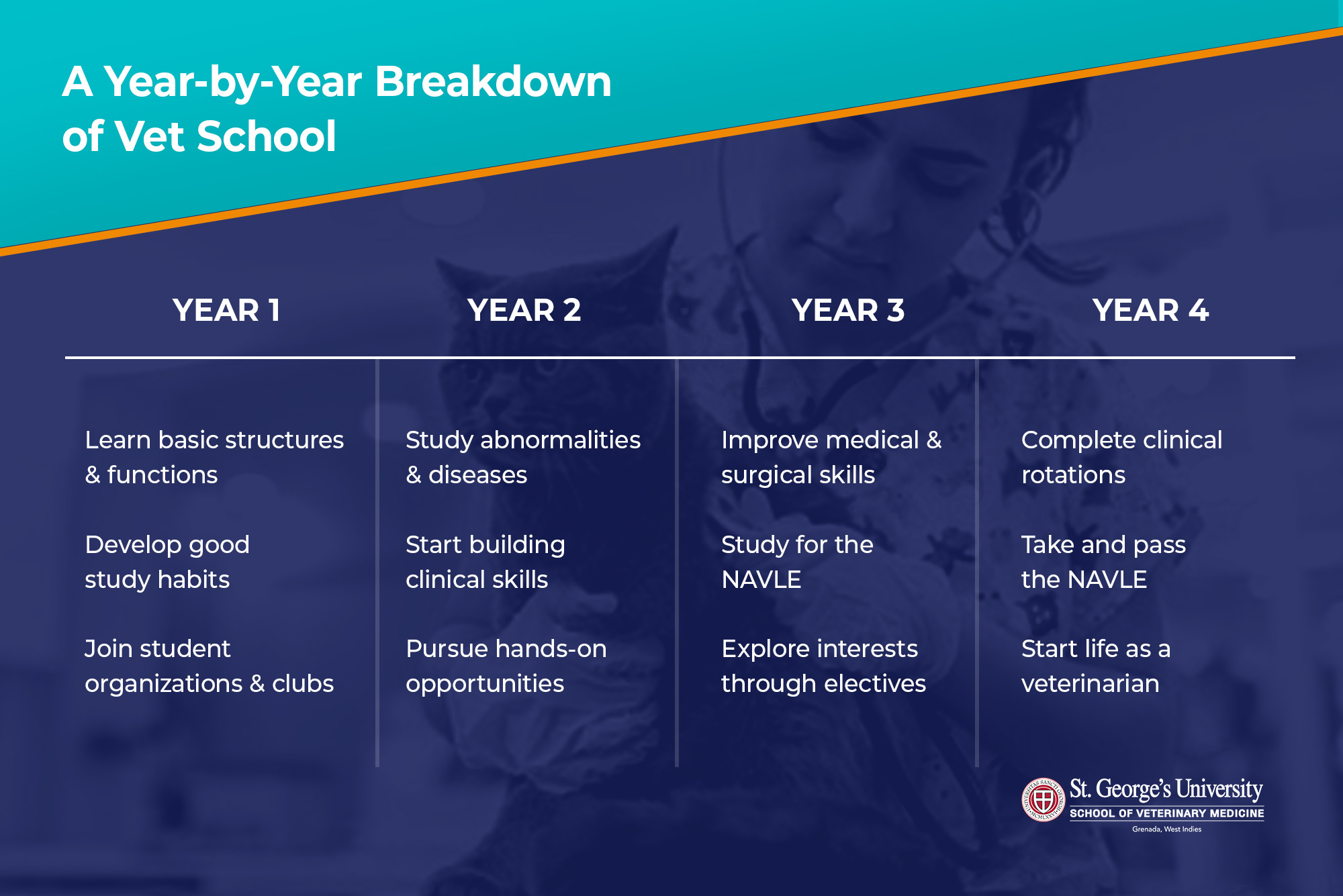Anyone interested in becoming a veterinarian will wonder how long it will take to get an education and vet training before they can practice. Unlike their counterparts who treat humans, the physicians of the animal world can address these requirements by the time they’ve obtained their advanced veterinary degree: a Doctor of Veterinary Medicine (DVM) . So those who are exploring this career path might wonder, “How long is vet school, and what does it involve?”
We created an overview to help you understand how to go from incoming DVM student to qualified veterinarian.
Exploring 4 years of veterinary training and education
Most students who want to pursue a career in veterinary medicine complete a four-year DVM program to gain the requisite qualifications. It’s important to note that while you can become a licensed veterinarian after four years of vet school, some DVMs do decide to specialize and complete a residency program after vet school. The additional training is needed to become board certified in areas like radiology, cardiology, and orthopedic surgery. Whether you’re interested in specializing or not, the breakdown below perspective can help illuminate what to expect throughout your veterinary education.

First year of veterinary school
What is vet school like during the first year? It entails labs and lectures that focus on teaching students about normal structures and functions in various species, which is essential knowledge that later courses will build upon. Understandably, developing good study habits in this initial year is essential.
“St. George’s University facilitates what they call DES (Department of Educational Services) sessions that are like tutoring sessions with an upperclassman who excelled in the class,” explains Dr. Cliff Petit, graduate of St. George’s University (SGU). Don’t be afraid to reach out to instructors for assistance either.
“Our professors are some of the most caring, intelligent, and patient people I have ever met,” says 2021 SGU alumni Britnee Frizol. “They genuinely want students to learn, retain information, and be able to apply it in practice.”
While most DVM programs introduce hands-on experiences during the second year, schools like SGU incorporate this type of practical training during year one. According to Frizol, students at St. George’s University start building practical skills working with animals almost immediately.
“Within the first week, you are taught how to do a physical exam on a variety of animals,” she says. “And the following day, you practice these skills on live animals!” Frizol also notes this early experience is really helpful for reinforcing what you learn in the classroom.
While school will be your primary focus, make sure to engage in other activities as well. Many veterinary schools hold a white coat ceremony for first-year students to mark their official entries into the veterinary profession. Students also have the opportunity to become active in different clubs and organizations.
“I was involved in an organization called VOICE: Veterinarians as One Inclusive Community for Empowerment,” Dr. Petit says. “It encourages diversity and celebrates diversity within the veterinary profession.”
Second year of veterinary school
Lectures and labs will continue into your second year, but there’s also a shift that occurs. “Year one is more about what’s normal to give you your foundation—normal anatomy, normal physiology, normal histology—and then year two is a bit more in depth,” Dr. Petit says. “That’s when they start introducing more pathology and what’s abnormal.”
During the second year, students typically begin to focus much more on developing their clinical skills as well. Some courses introduce students to the types of patients they might see, how to work up a case, and what it’s like to collaborate as part of a team.
“It is much more clinical in nature than the first year,” Frizol says. “You’ll learn about not only disease processes but also how these will present to you if you were to be standing in the hospital.”
Most DVM programs also start incorporating more hands-on work with animals during the second year. While not a requirement, students start to seek ways to gain practical experience outside of regular class. These opportunities are quite common at SGU for students in their first, second, or third year.
“There are tons of clubs that offer wet labs to their members and are open to students in terms one through six,” Frizol explains. “These wet labs further enhance a student’s ability to perform well in the clinical setting.”
Third year of veterinary school
The third year is sort of a transitional period before clinical rotations. The vet degree programs focus on teaching students how to diagnose, treat, and manage diseases and providing opportunities to develop technical surgical skills. For students, the number and nature of third-year experiences can vary depending on the school you attend. SGU, for instance, offers students an abundance of opportunities to work with patients and perform procedures.
“Students get to go on farm calls, prepare and scrub into various surgeries, and work emergency room and primary care shifts in the SGU Small Animal Clinic [SAC],” Frizol explains.
For Dr. Petit, working in the SAC was particularly beneficial.
“We got further experience doing spays and neuters—but also procedures like mass removals and fracture repairs under the guidance of the staff,” he recalls. “There were definitely a lot of opportunities to get clinical experience.”
It is also the time when students are also able to pursue unique interests through electives. Dr. Petit says that some courses, such as those related to parasitology, can even be helpful in preparation for the North American Veterinary Licensing Examination (NAVLE). You’ll need to secure a passing score on this test before you can begin practicing.
Fourth year of veterinary school
The fourth year of veterinary training before graduation is devoted to clinical rotations—practical experiences that prepare you for veterinary practice upon graduating. Rotations can vary considerably in terms of both animals and specialties among DVM programs. One of the advantages offered to students who attend SGU is that they can choose from more than 30 clinical training sites throughout the US, UK, Canada, Ireland, and Australia.
“Being able to choose my fourth-year school was beneficial in that I was able to learn the strengths and weaknesses of each teaching hospital before I picked one,” Frizol says.
Dr. Petit chose a program that not only appealed to his interests in small animal internal medicine but also introduced him to some unfamiliar animals.
“I was able to interact with a vast array of different species, especially in the large animal realm,” he reflects. “I saw reindeer, alpacas, and, of course, horses and cattle.” He adds that this period really helped him hone his problem-solving skills.
Fourth-year students will also need to study for and take the NAVLE at some point. It can feel intimidating, but Dr. Petit encourages future students to remain positive.
Once you’ve completed all rotations, obtained NAVLE results indicating a passing score, and addressed any state-specific licensing requirements, your time as a vet student will come to a close. While you can complete additional training to specialize, you’re also free to begin your career. No matter which option you choose, graduating from veterinary school is a huge accomplishment, so take some time to celebrate.
Become a standout vet school applicant
How long is vet school, and does it provide all the veterinary training you need to start your career? It’s probably become clear that completing a quality four-year program can equip you to begin practicing right after graduation.
There are many things you can do to improve your vet school application. If you’re interested in finding out how you can improve your odds of gaining acceptance to one of these great DVM programs, read our article “How to Gain Veterinary Work Experience for Your School Applications.”
*This article was originally published in 2021. It has since been updated to reflect new information.

